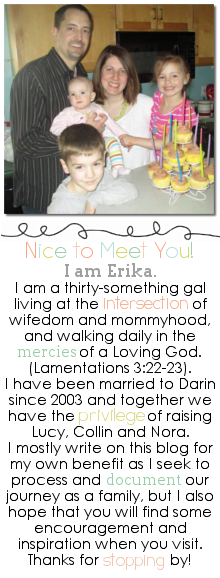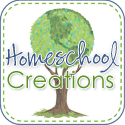A couple of things I try to keep in mind when it comes to helping my kids learn and grow in their social and emotional regulations skills:
- I try to remember that Darin and I are in this for the long haul. Our kids' hearts are tender and precious and right now they trust us with their feelings and they take their social cues from us. The way we handle their feelings now could lay the foundation as to whether they will trust us with them later in life. The examples we set for them in social interactions now is likely to influence how they relate to others as adults.
- It definitely pays off (at least in our experience) to "teach" about emotional regulation and social skills when they are not already in the midst of big and distressing feelings or a difficult social scenario. My hope is that when Lucy and Collin need redirection and/or correction in such moments, that the instructions I give are already familiar to them because they were addressed in a less escalated moment. Of course, sometimes, we don't realize specific areas that we need to work on with them until a situation becomes escalated, and other times it does not matter how much groundwork has been laid, things can just go badly. But you get what I'm saying!
Now, for the materials and resources that I have compiled for emotion regulation and social skills!
Here's what I have for ya!
I found this set of giant feelings stamps on Zulily and snatched them up. The set has ten face stamps, each one depicting a different feeling. Some of the feelings include: content, nervous, tired, scared, happy, sick, etc. Lucy and I have an ongoing project with these stamps. I give her a sheet of construction paper and ask her to choose one of the face stamps and the color of ink she wishes to use. After she stamps the image on her paper I tell her what the feeling is and I have her print the word on the sheet. Then she and I collaborate on making a list of what kinds of things bring about this feeling in her. Then she and I have fun looking in a mirror and making the facial expressions that match the feeling we've just talked about. She LOVES this activity, and when we have made a page for each of the ten feelings, I plan on assembling them together in a little booklet for her to revisit as she wishes.
2. Kimochis Mixed Feelings
This is a simple set of cute and quirky little softies that depict facial expressions and are labeled with the corresponding emotion. They are good for introducing and defining a variety of feelings in a gentle and playful way. Each "kimochi" is small enough to fit inside a little hand or be carried around in pockets, if that provides any comfort to little ones who are learning about BIG feelings.
3. Mr. Printables Emotion Flash Cards
The Mr. Printables website is so. Awesome. This is NOT the last time you will hear about Mr. Printables from me! They offer so MANY high quality FREE printable educational materials. LOVE them. These are some robot-themed emotion flash cards that provide another fun opportunity to expand a little one's awareness of emotions. These may especially appeal to any little boys out there who, like my Collin, love robots.
4. Mr. Printables Make a Face DIY Toy
See, I told you I would be talking about Mr. Printables again! This is such a clever little printable/DIY project. Print and cut out the face and individual facial features. The tutorial suggests mounting the pieces on cardboard but I printed mine on card stock and laminated them instead. The features are then attached to the face with brads. Once the piece is assembled, it can be used to show and talk about SO many different feelings. Children have fun experimenting with all the features and can see how just changing the position of the eyebrows can show an entirely different emotion. I also like that it includes teardrops-was able to use them along with the smile to help my kids start to grasp the concept that someone could cry "happy tears" which can be a very puzzling concept for them to consider.
5. Eeboo Polite Pig Activity Book
Eeboo is another name that I'll refer to often as well. I love Eeboo products for their beautiful visual design, physically sturdy materials and frequent depiction of cultural diversity, or, in the case of this charming little activity book, diversity and good breeding in the animal kingdom! : ) "Polite Pig and His Good Friends" is a simple coloring and activity book that I appreciate, not only for its introduction to good manners and politeness, but also for the exposure it gives to some basic mathematical and visual-spatial reasoning concepts.
6. Eeboo Make My Day Chart
Another offering from Eeboo, the "Make My Day Chart" is great tool to help little ones start out their day well with realistic expectations and goals. It is a sturdy cardboard wall hanging that incorporates little dials for kids to spin and select what day of the week it is, the calendar date, the season, current weather and what kind of clothing would be appropriate to choose. Children can then use the board to communicate the feelings they have as they start their day and express what things they wish to "try". At the end of the day children and parents can even use the board to choose a descriptor for how the day turned out and select a reward sticker if desired. This product is set apart from the other items I have mentioned so far because it makes the important connection between social and emotional functioning and an awareness of what is going on in our physical environment and how to begin orienting ourselves, our goals and our decisions according to the calendar.
7. Melissa and Doug Bear Dress Up Wooden Puzzle
This little puzzle from Melissa and Doug has been around for awhile, in fact I believe ours was handed down from my nieces who have practically grown up despite the fact that I specifically asked them not to! : ) This is a great addition to any toy and puzzle collection and proves to be another helpful way to introduce and identify moods and emotions as children can give the bear a different facial expression to go along with each outfit that may be interchanged on the puzzle.
8. The Big Picture Story Bible
I saved the best " learning resource" (in my opinion) for last When it comes to guiding my children through the difficult work of understanding and managing their feelings, it could be pretty easy to lead them down a path of self-absorption which will not serve them well. As a follower of Jesus, it is my conviction that the best way I can serve Lucy and Collin in this area of their life is to point them to our Heavenly Father and endeavor to show them the joys of entrusting their hearts to Him. We have several "Bible storybooks" in our home library and each one has been helpful in our efforts to introduce the scriptures to Lucy and Collin. The reason I highlight the Big Picture Story Bible in this list is because I feel that both the author and illustrator did a stunning job of portraying the emotional responses of mankind to God through the ages including joy, sorrow, fear, anger, etc. as well as God's response to mankind. Additionally, I appreciate the way the authors keep the individual stories flowing together to present the Bible as one big story about a great God. A great and loving God who invites them to trust Him with their big feelings, find forgiveness and be made new and whole through the cross of Christ Jesus.
Thanks for allowing me to share. I hope this collection of resources will be helpful for many of you, and if you feel so inclined to share with any other parents who are interested, I'd be honored. Also, would love to hear about any other resources or materials along these lines that you might recommend! I'll be working on adding more lists of my favorite learning resources little by little as I am able.
Xoxo,

















